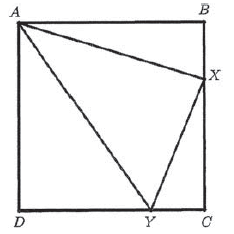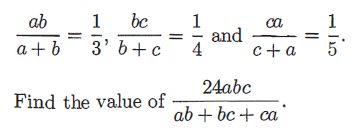SMO 2013 JUNIOR SECTION
Subscribe to our ▶️ YouTube channel 🔴 for the latest videos, updates, and tips.
Problem 10 :
Let S be the smallest positive multiple of 15, that comprises exactly 3k digits with k 0's, k 3's and k 8's. Find the remainder when S is divided by 11.
(a) 0 (b) 3 (c) 5 (d) 6 (e) 8
Solution :
Since S is the multiple of 15, it should be multiple of 3 as well 5.
- If it is multiple of 3, its sum of the digits should be divisible by 3.
- If it is multiple of 5, its unit digit should be 0 or 5.
Possible values to fill up in the places are 0, 3, and 8. Accordingly the condition, the unit digit can be fixed with 0.
The required number will consist of 9 digits(since it is the smallest number).
3 ==> 0's, 3 ==> 3's and 3 ==> 8's
300338880
Sum of the digits = 3 + 0 + 0 + 3 + 3 + 8 + 8 + 8 + 0
= 9 + 24 ==> 33(divisible by 3)
Divisibility rule for 11 :
Find the difference of sum of alternative digits.
3 + 0 + 3 + 8 + 0 ==> 14
0 + 3 + 8 + 8 ==> 19
14 - 19 ==> 5 (mod 11) ==> 6
So, the required remainder is 6.
Problem 12 :
If the graphs of y = x2 + 2ax + 6b and y = x2 + 2bx + 6a intersect at only one point in the xy-plane, what is the x-coordinate of the intersection ?
Solution :
To find the point of intersection, we can solve the system of equations.
y = x2 + 2ax + 6b ---(1)
y = x2 + 2bx + 6a ----(2)
(1) = (2)
x2 + 2ax + 6b = x2 + 2bx + 6a
2ax + 6b = 2bx + 6a
2ax - 2bx + 6b - 6a = 0
2x(a - b) + 6(b - a) = 0
2x(a - b) - 6(a - b) = 0
Dividing by (a - b) on both sides.
2x - 6 = 0
2x = 6
x = 6/2
x = 3
So, the required x-coordinate is 3.
Problem 17 :
Let ABCD be a square and X and Y be the points such that lengths of XY, AX and AY are 6, 8 and 10 respectively. The area of ABCD can be expressed as m/n units where m and n are positive integers without common factors. Find the value of m + n.

Solution :
AY = 10, XY = 6 and AX = 8
(AY)2 = (XY)2 + (AX)2
102 = 62 + 82
Since it satisfies Pythagorean theorem, AXY must be a right triangle.
Area of square = AB2 = BC2 = CD2 = DA2
In triangles ABX and CXY.
∠ABX = ∠XCY
∠AXB = ∠XYC
AX/XY = AB/XC
8/6 = AB/XC
4/3 = AB/XC
4/3 = AB/(BC - BX)
4/3 = AB/(AB - BX)
4(AB - BX) = 3AB
4AB - 4BX = 3AB
AB = 4BX ---(1)
Area of square = (AB)2 = (4BX)2
(AX)2 = (AB)2 + (BX)2
82 = (4BX)2 + (BX)2
64 = 16(BX)2 + (BX)2
17 (BX)2 = 64
BX = 8/√17
By applying the value of BX in (1), we get
AB = 4(8/√17)
AB = (32/√17)
(AB)2 = (32/√17)2 ==> 1024 / 17
m + n = 1024 + 17 ==> 1041
Problem 20 :
Let a, b and c be real numbers such that

Solution :
Problem 27 :
Find the least positive integer n such that
28 + 211 + 2n
is a perfect square.
Solution :
Since 28 + 211 + 2n is a perfect square.
Let the required perfect square be m2.
28 + 211 + 2n = m2
2n = m2 - 28 - 211
2n = m2 - 28 (1 + 23)
2n = m2 - 28 (9)
2n = m2 - 28 (32)
2n = m2 - (3(24))2
2n = m2 - (48)2
2n = (m + 48)(m - 48)
If 2k = m + 48 ---(1), then 2n-k = m - 48 ----(2)
(1) - (2)
2k - 2n-k = 96
Decomposing 96, we get25 x 3
2n-k(22k-n - 1) = 25 x 3
n - k = 5 and 2k - n = 2
Adding these two
k = 7
Applying the value of k, we get
n - 7 = 5
n = 12
So, the answer is 12.
Problem 34 :
What is the smallest positive integer value of n such that the following statements is always true ?
In any group of 2n - 10 persons, there are always at least 10 persons who have the same birthdays.
(For this question, you may assume that are exactly 365 different possible birthdays)
Solution :
We can say as, if n + 1 objects are put into n boxes, then at least one box contains two or more objects.
In any group of 365 x 9 + 1 persons, there must be at least persons who share the same birthdays.
So, in the group of 3286 persons at least 10 will share the same birthdays.
Here, 2n - 10 ≥ 3286
2n ≥ 3296
n ≥ 1648
So, the smallest value of n is 1648.
Applying n = 1647
2(1647) - 10 = 3284 < 365 x 9
and it is possible for each of the 365 different birthdays to be shared by at most 9 persons.
Problem 35 :
What is the smallest positive integer n, where n ≠ 11, such that the highest common factor of n - 11 and 3n + 20 is greater that 1 ?
Solution :
Subscribe to our ▶️ YouTube channel 🔴 for the latest videos, updates, and tips.
Recent Articles
-
Finding Range of Values Inequality Problems
May 21, 24 08:51 PM
Finding Range of Values Inequality Problems -
Solving Two Step Inequality Word Problems
May 21, 24 08:51 AM
Solving Two Step Inequality Word Problems -
Exponential Function Context and Data Modeling
May 20, 24 10:45 PM
Exponential Function Context and Data Modeling